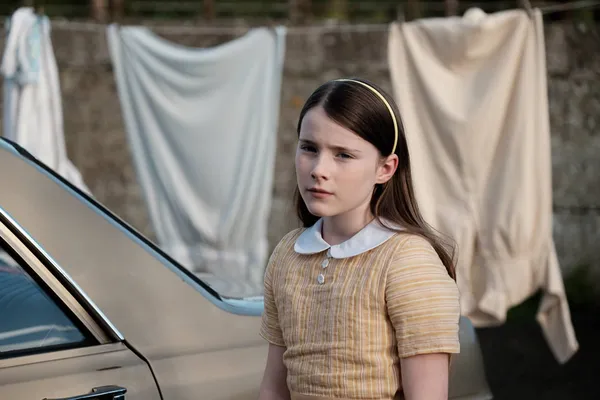 |
| Catherine Clinch as Cáit in The Quiet Girl |
Irish director Colm Bairéad's debut feature, The Quiet Girl (An Cailín Ciúin), an adaptation of Claire Keegan's novella Foster, centres on Cáit, a young girl despatched for the summer to the temporary care of surrogate parents, Eibhlin and Seán Cinnsealach.
Although Seán is initially distant towards Cáit, she blossoms in their care. As the Cinnsealach's tragic past is revealed, the relationship with their temporary foster daughter becomes more emotionally complicated. Set against the backdrop of rural Ireland, the three characters fill a void in one another in what is a mutually transformational experience.
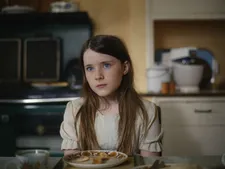 |
| The Quiet Girl |
In conversation with Eye For Film, Bairéad discussed having faith that simple storytelling can yield something complex and compelling, honouring the spirit of Keegan’s novella, and the transformation of tragedy into a life affirming message.
Paul Risker: It’s a commitment to make a film, requiring you to give up a period of your life. What compelled you to believe in this film and decide to adapt Keegan’s novella?
Colm Bairéad: The impulse to try to adapt it came from a place of compassion – of feeling for this young girl and what the Cinnsealach’s, the surrogate parents, are going through and what they’ve been through. Also the fascination with the notion of a film that's not worried about plot, that understands the plot isn't why we're here, it's actually about examining the dynamic of these characters.
… I'm a sucker for films that have a definite point-of-view. This is a first person narrative - you're seeing it all through this girl’s eyes. The same was true in the manner the novel was written in the present tense, and so it feels immersive. To me it felt visual and I could see the world, and I could see how it could be translated into the language of film.
In a weird way, I just had a belief in the smallness of the story, that there was something appealing. It was the notion that if we look closely enough at what is a fleeting event in the lives of these characters, we could find something profound.
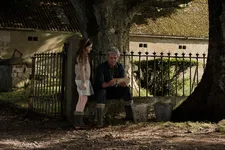 |
| The Quiet Girl |
PR: Audiences have been taught to identify plot, and to interrogate the objective of a film. The Quiet Girl, which I regard as a patient form of storytelling challenges this. The objective is not immediately clear, instead the audience must be patient as the characters connect, slowly revealing the intent.
CB: Some of that's down to personal taste in terms of film. I enjoy films that allow that space for the characters and the audience. There’s a limit as to how far you can go, and some filmmakers go far with that level of restraint. I hope we managed to strike a balance, in terms of taking time and allowing the emotional restraint of the piece to register, but also that it's still something that holds you as an audience, and compels you to some degree, even in the absence of any great plot developments.
It’s more about feeling your way through the film and actually feeling your way through how this character is interpreting what's happening around her, and the people she's engaged with. I love the films by Kelly Reichardt for instance, the American director who has a similar approach. This notion of a simplistic style, but one that yields something complex, is appealing to me.
PR: Moments in life when we learn, or, come to understand are not necessarily dramatic. They’re shrouded in a calmness, and instead of seeking to dramatise, here you convey this experience in your approach.
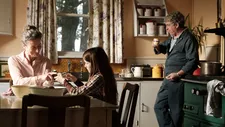 |
| The Quiet Girl |
CB: It's about gradually allowing the audience and the main character to figure out the emotional landscape – what has happened with the Cinnsealach’s. By taking its time, it allows you to get to know the characters and become emotionally invested in them. When you do hit those moments of higher drama, it builds to this massive cathartic moment.
The film which has been restrained up until that point, similarly to Cáit running off, allows itself to let loose and embrace the emotion of the moment. It feels like that's registering with audiences and they're affected by it. This was the experience I had reading Claire’s work.
PR: Should an adaptation be an extension of the source material, less about being faithful to the narrative, and more about honouring the spirit of the story and its characters?
CB: I was keenly aware of the perceived wisdom that being too faithful to the original is not necessarily a good thing. At the same time, in many respects, the film is faithful to the original.
Early on, I realised the source material wasn't substantial enough to stretch it over the canvas of a three act structure. The first act of the film is an invented sequence that's not in the book. There are some brief references in the novella to prior moments in Cáit’s past that I seized upon to expand it, and develop the scenes to form the first act. There was that element of having to construct further scaffolding around the novella.
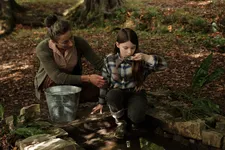 |
| The Quiet Girl |
… Ultimately what you say is correct - the most important thing is that you're capturing the essence of the work, and you've an understanding of what the work is saying. You're mindful of that and you're ensuring the film is an embodiment of that statement, by embodying the themes and the intent that are present in the book. We've managed to do that, and hopefully the process of adaptation yields something that is its own thing, by bringing some other layers to it that people can discern.
PR: The Quiet Girl is a tragic piece of storytelling, reminding us that life will sometimes give us either what we need or what we want, and in other times it will give us neither. This is one of the dominant themes of the film, through the way in which Cáit and the Cinnsealach’s complete one another.
CB: It’s a tragic story in a sense because Cáit has to go back to her own family, and the Cinnsealach’s have to go back to their own lives, without their own child, and now without this surrogate child they had for a brief moment.
There’s another way of looking at it, which is they've each gained something from the experience they've had over the course of the summer. Cáit has grown emotionally and psychologically. The fact that she runs down the driveway at the end of the film and embraces the Cinnsealach’s, and says what she says, is an illustration of how much she has grown. It’s her saying to the Cinnsealach’s that she loves them, and she's thankful for what they've done for her. But it’s also her saying, I see and understand the pain that you've gone through. To me that’s a coming-of-age moment, a sign that she’s becoming a young woman of sorts, or, certainly a young person who has this greater understanding.
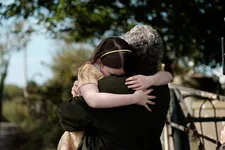 |
| The Quiet Girl |
All those things you talk about, how life can be full of warmth, love and wonder, but it can also be painful and tragic, these are not mutually exclusive. Those two things can co-exist in a magical place like the Cinnsealach’s.
There's a tragedy to it, but I'm hopeful for Cáit’s character. I know that she's going to carry this experience with her going forward in her life and there was also something in it for the Cinnsealach’s. It may have opened up some old wounds, but it's ultimately going to be a healing process for them.
PR: Coming-of-age has been defined as a period in one’s youth, but if the psychological idea that experiences allow us to grow, is it restricted to this one period of our lives? In this film, the adults are examples of how we transform through our experiences, suggesting that the coming-of-age cycle never ends.
CB: It's not just about the transformative process for Cáit’s character, it's about what the adults are going through. It's about them facing up to the pain in their own lives. I look at Cáit’s father who is a broken man. I don't think he can, or, would ever change in terms of his essential outlook, or, the way he communicates with his children, or, fails to communicate. I still think the brief glimpse he gets of Cáit and how she's engaging with these surrogate parents challenges and stirs something, that injures him as a father.
Coming-of-age isn’t something that should be confined to the younger protagonists in these films. There are other ancillary adult characters that are going through similar shifts.
The Quiet Girl is available in theatres and on Curzon Home Cinema now.





















